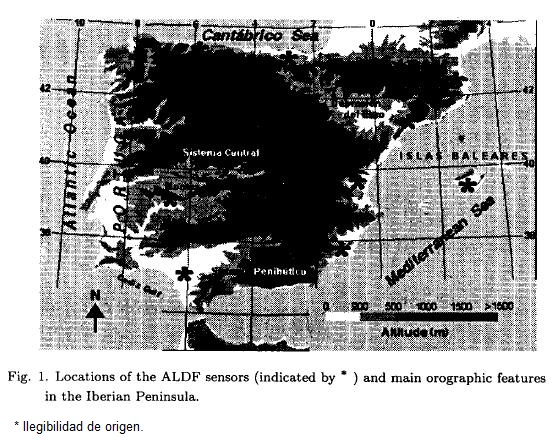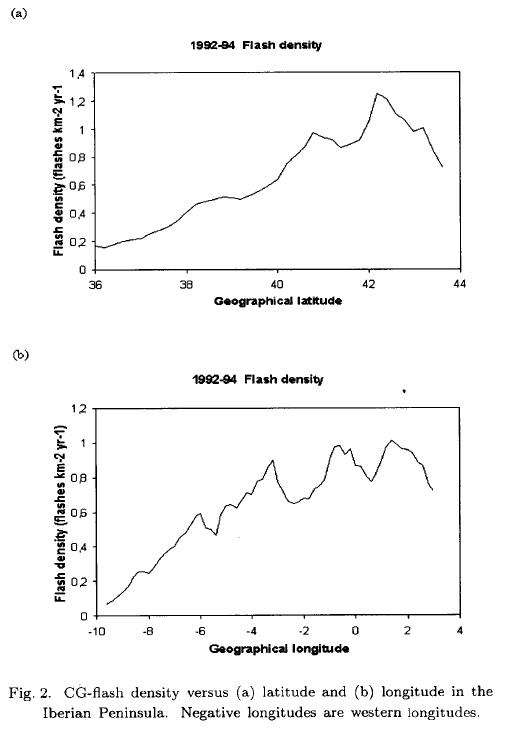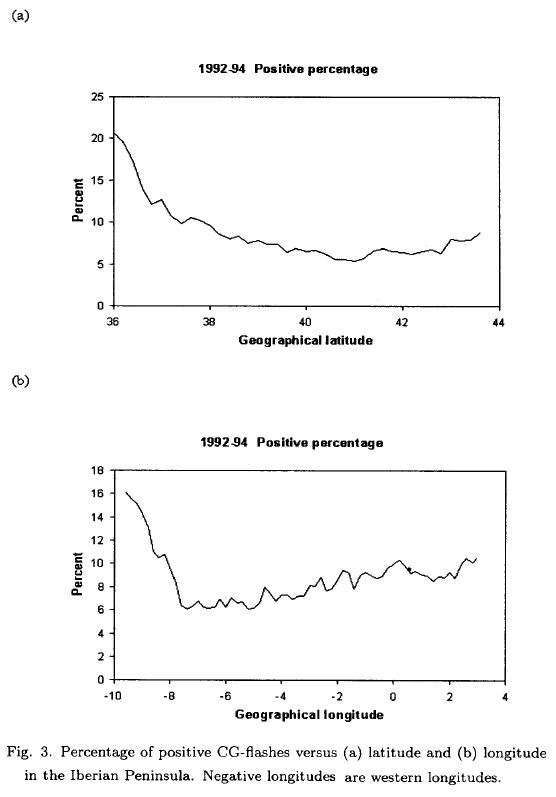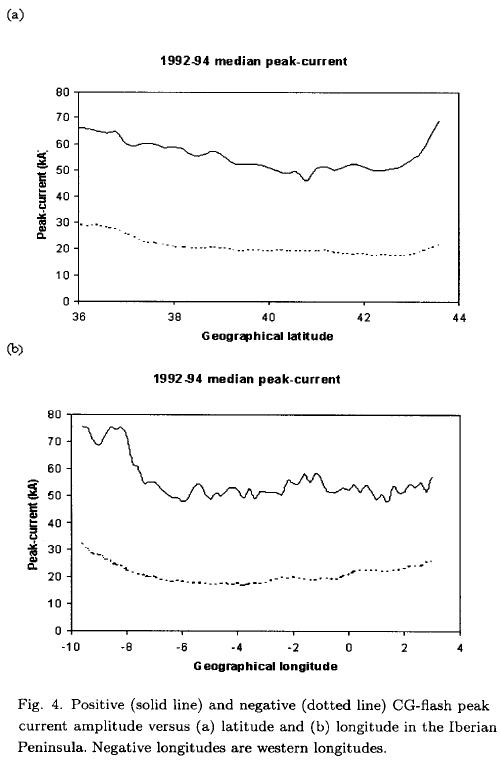Services on Demand
Journal
Article
Indicators
-
 Cited by SciELO
Cited by SciELO -
 Access statistics
Access statistics
Related links
-
 Similars in
SciELO
Similars in
SciELO
Share
Atmósfera
Print version ISSN 0187-6236
Atmósfera vol.15 n.3 Ciudad de México Jul. 2002
Relationship between geographical latitude and longitude and cloud-to-ground lightning flash characteristics in the Iberian Peninsula
L. RIVAS SORIANO, F. DE PABLO and E. GARCIA DIEZ
Departamento de Física de la Atmósfera, Universidad de Salamanca, Spain
(Manuscript received March 26, 2001; accepted in final form Sept. 24, 2001)
RESUMEN
Se analiza la relación entre latitud y longitud y los rayos nube-tierra en la Península Ibérica, utilizando datos desde 1992 hasta 1994. Se consideran tres características de los rayos: densidad, polaridad e intensidad. Se ha encontrado una fuerte dependencia entre densidad y tanto latitud como longitud. Esta dependencia puede explicarse por la distribución de altitudes y el efecto del mar Mediterráneo, respectivamente. La polaridad también muestra una fuerte dependencia con la latitud, explicable por el efecto de complejos convectivos mesoescalares y la temperatura. La dependencia entre longitud y polaridad es débil, y puede ser debida a la mayor intensidad de los rayos positivos y el efecto de complejos convectivos mesoescalares. La intensidad, para las dos polaridades, muestra una clara relación con la latitud, debida a efectos orográficos y al hecho de que los canales de descarga sean mayores a menor latitud. No parece existir una clara dependencia entre intensidad y longitud.
ABSTRACT
The relationship between geographical latitude and longitude and cloud-to-ground lightning activity in the Iberian Peninsula is analyzed using data from 1992 until 1994. Three flash characteristics are considered: flash density, polarity and intensity. There is a strong dependence between flash density and both latitude and longitude, which may be explained as effect of altitude distribution and the Mediterranean sea respectively. The polarity also shows a strong dependence with latitude, which may be explained as effect of mesoscale convective systems (MCS) and temperature. The dependence between geographical longitude and polarity is weak and may be due to the higher intensity of the positive flashes together with the effect of MCSs. Peak-current amplitudes for both polarities show a clear relationship with latitude, which may be explained by orographic effects and the longer lightning channels at lower latitudes. A definite dependence between peak-current amplitudes and geographical longitude is not observed.
Key words: Atmospheric electricity, convective processes, lightning characteristics, Iberian Peninsula.
1. Introduction
Lightning activity is physically related with thunderstorms and it is a major cause of weather-related deaths, property damage and power system breakdowns. The combination of lightning data with radar observations may be used in the now-casting of convective systems (Stern et al., 1994). Lightning can be used to estimate convective rainfall (i.e. Petersen and Rutledge, 1998). Because of the sensitivity of the global circuit to change in surface air temperature, it may also be used as an indicator of change in the global temperature (Williams, 1992, 1994; Reeve and Toumi, 1999). There is further interest in lightning activity, since it plays a fundamental role as a cause of natural forest fires in mid-latitudes (i.e. Krider et al., 1980) and it is a source of nitrogen oxide and, hence, of tropospheric ozone (Franzblau and Popp, 1989; Toumi et al., 1996).
There are many works reporting the spatial distribution of flash characteristics. For example, Orville (1991, 1994), Orville and Silver (1997) and Orville and Huffines (1999) analysed the geographical distribution of cloud-to-ground (CG) lightning activity in the contiguous United States, Hodanish et al. (1997) in the state of Florida, Hidayat and Ishii (1998) around Java, Pinto et al. (1999) in Brazil, Finke and Hauf (1996) in Germany and Rivas et al. (2001b) on the Iberian Peninsula. These works show that the spatial distribution of CG-flash density is clearly related to the orography. Moreover, a tendency in the flash density to increase with altitude has been reported by several authors (i.e. Reap, 1986 in the United States; Pinto et al., 1999 in Brazil; Rivas et al., 2001a in Spain). The relationship of flash characteristics with geographical latitude and longitude is less investigated. Mackerras and Darveniza (1994) and Mackerras et al. (1998) analysed the global relationship between total flash density and latitude and Yair et al. (1998) studied this relationship for Israel. These works suggest that flash density decreases with latitude. Orville (1994) found a strong dependence between polarity and latitude in the contiguous United States. Orville (1994) and Pinto et al. (1999) suggested that the peak current amplitude also varies as a function of latitude.
In this work we have considered the Iberian Peninsula and analysed the relationship between geographical latitude and longitude and three CG-flash characteristics: flash density, polarity and intensity.
2. Lightning data
The lightning detection system installed on the Iberian Peninsula and belonging to the Instituto Nacional de Meteorología consists of a network of 13 sensors distributed throughout the Spanish territory (Fig. 1). This lightning detection network uses ALDF model 141-T and is similar to those used in other countries. Some characteristics of the lightning detection network have been described by Martin (1995) and Rivas et al. (2001b). It can only detect CG-fiashes. The system detect CG-flashes through the signal produced by the magnetic field of a lightning flash. The direction of the flash is determined from the signals from two or three sensors. Thus, CG-flashes can be detected in areas where there are no sensors. However, the number of detected flashes will decrease as the distance from the perimeters of the lightning detection network increases. In particular, distant weak flashes will not be detected. Detection efficiency is defined as the ratio between the number of detected flashes and the actual number of flashes. Since there are no sensors located over Portugal, we expect a lower detection efficiency in this country than in Spain. However, as Portugal is close to the perimeter of the lightning detection network, it is assumed that the diminution of detection efficiency is low. In fact, an overall detection efficiency of 70% is quoted for the lightning detection network in the Iberian Peninsula (Rivas et al., 2001b).

In this study we have considered the area located between 36°N and 43.8°N latitudes and between 3.2°E and 9.6°W longitudes, which includes the whole Iberian Peninsula. The data set covers the years 1992-94. Over 2.2 million cloud-to-ground lightning flashes were recorded in this period (Rivas et al., 2001b).
3. Results and discussion
In order to investigate the latitude/longitude dependence of CG-flash density, we have averaged over longitude/latitude respectively. The results appear in Figure 2. Figure 2a shows a clear relationship between flash density and latitude. The correlation coefficient is 0.93. The bilateral significance of this correlation is 0.000, which implies that the p-level significance is 0.01. The maximum flash density is found between 41°-43°N. This may be explained as an orographic effect of the Pirineos. This is the most relevant mountain range in the Iberian Peninsula and the orographic forcing causes an enhancement in convection. As a consequence, the highest lightning activity is always fixed to the Pirineos, as reported by Rivas et al. (2001b). Neglecting this maximum associated with the Pirineos, it is apparent that the flash density increases with latitude. This relationship between flash density and latitude is different from the one reported by other authors at both global and local scales (Mackerras and Darveniza, 1994; Mackerras et al., 1998; Yair et al., 1998), who reported that flash density decreases with latitude. Several studies show that lightning activity is mostly affected by the moisture content (e.g. Petersen et al., 1996; Rivas et al., 2001a; De Pablo and Rivas, 2001). Thus, it is expected that the lightning activity decreases as the humidity content decreases. The southern Iberian Peninsula is a dry area and, as a consequence, the lack of moisture in this zone may partly explain the above mentioned behavior. A tendency of flash density to increase with altitude has been reported by several authors (Reap, 1986; Pinto et al., 1999; Rivas et al., 2001a). The mean altitude of the Iberian Peninsula increases northwards (García and Reija, 1994). This fact may also contribute to explain the relationship between flash density and latitude which is found in the Iberian Peninsula.

The CG-flash density as a function of longitude appears in Figure 2b. The correlation coefficient is 0.90. The bilateral significance of this correlation is 0.000, which implies that the p-level significance is 0.01. The minimum flash density is found within the western limit of the Iberian Peninsula, and is followed by a rise to the maximum around 3°W. From this longitude up to the eastern limit there is not a clear relationship between flash density and longitude. Longitude 3W corresponds with that of the Mediterranean coast, where thunderstorms are frequent, due to the effect of the moist warm air from the Mediterranean sea. In consequence, the relationship between CG-flash density and longitude seems to reflect the relevance of the Mediterranean sea on lightning activity in the Iberian Peninsula.
In order to analyse the relationship between polarity and latitude and longitude, we have averaged the percentage of positive flashes over longitude and latitude respectively. The results are shown in Figure 3. Figure 3a shows the percentage of positive flashes as a function of latitude. The correlation coefficient is -0.70. This correlation is significant (bilateral significance 0.000 and p-level significance 0.01). From a peak value at around 36°N, the percentage drops to a minimum at about 40°N. A large number of positive flashes has been observed in association with the trailing stratiform region of mesoscale convective systems (MCS) (e.g. Rutledge and McGorman, 1988; Rutledge et al, 1990). In the southern and eastern Iberian Peninsula MCSs are frequent storm types. This may explain the large number of positive flashes found between 36°N and 38°N. From 38°N to 44°N, where little influence of MCSs is found, it is apparent that the percentage of positive flashes increases with latitude. The latter is in agreement with other studies. Orville (1994) found a strong latitude dependence in the contiguous United States and suggested that this dependence is an effect of temperature. The charge separation is a function of the temperature (e.g. Dong and Hallett, 1992) and, as a consequence, with increased latitude the charged region of the cloud will be closer to the surface. Under this condition, more positive streamers coming from the upper positive charge center of the cloud can reach the ground, increasing the percentage of positive flashes.

Figure 3b shows the percentage of positive flashes as a function of longitude. In this case, the correlation coefficient is only -0.08 and the correlation is not significant (bilateral significance 0.51). This result is due to the high percentage of positive flashes found between 10°W and 8°W. Positive flashes have higher peak current amplitudes than negative flashes. Rivas et al. (2001b) e.g. reported mean (median) peak current amplitudes of 32.4 kA (22.5 kA) for the negative flashes and 69.3 kA (52.3 kA) for the positive flashes in the Iberian Peninsula. In consequence, a higher percentage of positive flashes will be recorded as their distance increases from the perimeter of the lightning detection network. The lightning detection network installed on the Iberian Peninsula does not have any sensor to the west (Fig. 1). Thus, the high percentage of positive flashes between 10°W and 8°W is due to this effect. Neglecting this longitude interval, there appears that the positive flashes increase with longitude. MCSs are frequent in the eastern Iberian Peninsula. Thus we might expect to see an increase in the percentage of positive flashes towards the eastern Iberian Peninsula. This behavior has also been reported by Orville (1994) for the contiguous United States.
The latitude and longitude dependences of the peak-current amplitude are shown in Figure 4. We have considered the median peak-current instead of the mean peak-current because peak-currents are not normally distributed (i.e. Rivas et al., 2001b). Figure 4a shows the negative and positive peak-currents as a function of the geographical latitude. The correlation coefficients are -0.79 for the negative flashes and -0.52 for the positive flashes. The p-level significance for these correlation coefficients is 0.01 (bilateral significance 0.000 and 0.001 respectively). The northern limit of the Iberian Peninsula (between 43°N and 44°N) shows the highest median peak-current amplitudes, specially for the positive flashes. This is probably an effect of the large number of flashes counted over the Pirineos, being therefore an orographic effect. Neglecting this effect, the lower the latitude, the higher the peak-current for both polarities. Such a variation is in apparent agreement with the results for negative flashes obtained by Orville (1994) in the United States and Pinto et al. (1999) in Brazil. Orville (1994) suggested that the peak current may vary as a function of latitude due to the longer lightning channels at lower latitudes. Figure 4b shows the negative and positive median peak-current amplitudes as a function of longitude. The correlation coefficients are -0.56 for the positive flashes and -0.07 for the negative flashes. The p-level significance of the first correlation coefficient is 0.01 (bilateral significance 0.000), but the correlation for the negative flashes is not significant (bilateral significance 0.58) Neglecting the longitude interval between 10°W and 8°W, where the decrease of peak currents is clearly explained by the effect of their distance from the perimeter of the lightning detection network mentioned above, there seems to exist no definite dependence between longitude and peak currents. Results indicate a minimum for the negative flashes between 6°W and 2°E, which agrees with the low median peak-current values reported for the central areas of the Iberian Peninsula (Rivas et al., 2001b).

4. Conclusions
The relationship between geographical latitude and longitude and the CG-lightning activity on the Iberian Peninsula is analyzed using data from 1992 until 1994. Three flash characteristics are considered: flash density, polarity and intensity. A clear positive correlation between flash density and latitude is found, showing that the flash density increases with latitude. This relationship is an effect of the altitude distribution in the Iberian Peninsula. The flash density also shows a clear linear relationship with geographical longitude, which may be an effect of the Mediterranean sea, since it supplies warm and moist air enhancing thus convective activity.
The relationship between the percentage of positive flashes and geographical latitude shows one peak within the southern limit of the Iberian Peninsula. This maximum is related to the MCSs, that are frequent in the southern and eastern Iberian Peninsula. Neglecting this effect, it appears that the percentage of positive flashes increases with latitude, in agreement with the results reported Orville (1994) for the contiguous United States. The percentage of positive flashes shows its highest value within the western limit of the Iberian Peninsula because positive flashes present a higher intensity than negative flashes and, in consequence, more positive flashes will be recorded as their distance increases from the perimeter of the lightning detection network. Being this effect neglected, it appears that positive flashes increase with geographical longitude. This may be explained by the mentioned MCSs. Neglecting the orographic effect of the Pirineos, the median peak-current amplitudes for both polarities decrease with latitude, in agreement with the results reported by Orville (1994) for the contiguous United States. In contrast, median peak-current amplitudes do not show dependence with geographical longitude.
Acknowledgements
Partial support for this work was provided by the Junta de Castilla y Leon and the European Union (Grant SA011/01)
REFERENCES
De Pablo, F. and L. Rivas, 2001. Relationship between cloud-to-ground lightning flashes over the Iberian Peninsula and sea surface temperature, Quart. J. Roy. Meteor. Soc., in press.
Dong, Y. and J. Hallett, 1992. Charge separation by ice and water drops during growth and evaporation, J. Geophys. Res., 97, 20,361-20,371. [ Links ]
Finke, U. and T. Hauf, 1996. The characteristics of lightning occurrence in Southern Germany, Beitr. Phys. Atmosph., 69, 361-374. [ Links ]
Franzblau, E. and C. J. Popp, 1989. Nitric oxides produced from lightning, J. Geophys. Res., 94, 11,089-11,104. [ Links ]
García de Pedraza, L. and A. Reija Garrido, 1994. Tiempo y clima en España, 410 pp., Ed. Dossat, Madrid. [ Links ]
Hidayat, S. and M. Ishii, 1998. Spatial and temporal distribution of lightning activity around Java, J. Geophys. Res., 103, 14,001-14,009. [ Links ]
Hodanish, S., D. Sharp, W. Collins, C. Paxton and R. E. Orville, 1997. A 10-yr monthly lightning climatology of Florida: 1986-95, Weather For., 12, 439-448. [ Links ]
Krider, E. P., R. C. Noggle, A. E. Pifer and D. L. Vance, 1980. Lightning direction finding system for forest fire direction, Bull. Amer. Met. Soc., 61, 980-986. [ Links ]
Mackerras, D. and M. Darveniza, 1994. Latitudinal variation of lightning occurrence characteristics, J. Geophys. Res., 99, 10,813-10,821. [ Links ]
Mackerras, D., M. Darveniza, R. E. Orville, E. R. Williams and S. J. Goodman, 1998. Global lightning: total, cloud and ground flash estimates, J. Geophys. Res., 103, 19,791-19,809. [ Links ]
Martín, F., 1995. Actividad tormentosa en la península y áreas limítrofes durante el verano de 1994, 27 pp. Technical note no. 23, Instituto Nacional de Meteorología, Madrid. [ Links ]
Orville, R. E., 1991. Lightning ground flash density in the contiguous United States-1989, Mon. Weather Rev., 119, 573-577. [ Links ]
Orville, R. E., 1994. Cloud-to-ground lightning flash characteristics in the contiguous United States: 1989-1991, J. Geophys. Res., 99, 10,833-10,841. [ Links ]
Orville, R. E. and A. C. Silver, 1997. Lightning ground flash density in the contiguous United States: 1992-95, Mon. Weather Rev., 125, 631-638. [ Links ]
Orville, R. E. and G. R. Huffines, 1999. Lightning ground flash measurements over the contiguous United States: 1995-1997, Mon. Weather Rev., 127, 2693-2703. [ Links ]
Petersen, W. A., S. A. Rutledge and R. E. Orville, 1996. Cloud-to-ground lightning observations from TOGA COARE: selected results and lightning location algorithms, Mon. Weather Rev., 124, 602-620. [ Links ]
Petersen, W. A. and S. A. Rutledge, 1998. On the relationship between cloud-to-ground lightning and convective rainfall, J. Geophys. Res., 103, 14,025-14,040. [ Links ]
Pinto, O. Jr., I. R. C. A. Pinto, M. A. S. S. Gomes, I. Vitorello, A. L. Padilha, J. H. Diniz, A. M. Carvalho and A. Cazetta Filho, 1999. Cloud-to-ground lightning in southeastern Brazil in 1993. 1. Geographical distribution, J. Geophys. Res., 104, 31,369-31,379. [ Links ]
Reap, R. M., 1986. Evaluation of cloud-to-ground lightning data from the western United States for the 1983-84 summer seasons, J. Clim. Appl. Meteorol, 25, 785-799. [ Links ]
Reeve, N. and R. Toumi, 1999. Lightning activity as an indicator of climate change, Quart. J. Roy. Meteor. Soc., 125, 893-903. [ Links ]
Rivas, L., F. De Pablo and E. García, 2001a. Meteorological and geo-orographical relationships with lightning activity in Castilla-Leon (Spain), Meteorol. Appl., 8, 169-175. [ Links ]
Rivas, L., F. De Pablo and E. García, 2001b. Cloud-to-ground lightning activity in the Iberian Peninsula: 1992-94. J. Geophys. Res., 106, 11,891-11,901. [ Links ]
Rutledge, S. A. and D. R. MacGorman, 1988. Cloud-to-ground lightning activity in the 10-11 June 1985 mesoscale convective system observed during Oklahoma-Kansas PRESTORM Projet, Mon. Weather Rev., 116, 1393-1408. [ Links ]
Rutledge, S. A., C. Lu and D. R. MacGorman, 1990. Positive cloud-to-ground lightning in mesoscale convective systems, J. Atmos. Set., 47, 2085-2100. [ Links ]
Stern, A. D., R. H. Brady, P. D. Moore and G. M. Carter, 1994. Identification of aviation weather hazards based on the integration of radar and lightning data, Bull. Amer. Met. Soc., 75, 2269-2280. [ Links ]
Toumi, R., J. Haigh and K. S. Law, 1996. A tropospheric ozone lightning climate feedback, Geophys. Res. Lett., 23, 1037-1040. [ Links ]
Williams, E. R., 1992. The Schuman resonance: a global tropical thermometer, Science, 256, 184-1187. [ Links ]
Williams, E. R., 1994. Global circuit response to seasonal variations in global surface air temperature, Mon. Weather Rev., 112, 1917-1929. [ Links ]
Yair, Y., Z. Levin and O. Altaratz, 1998. Lightning phenomenology in the Tel-Aviv area from 1989 to 1996, J. Geophys. Res., 103, 9015-9025. [ Links ]














